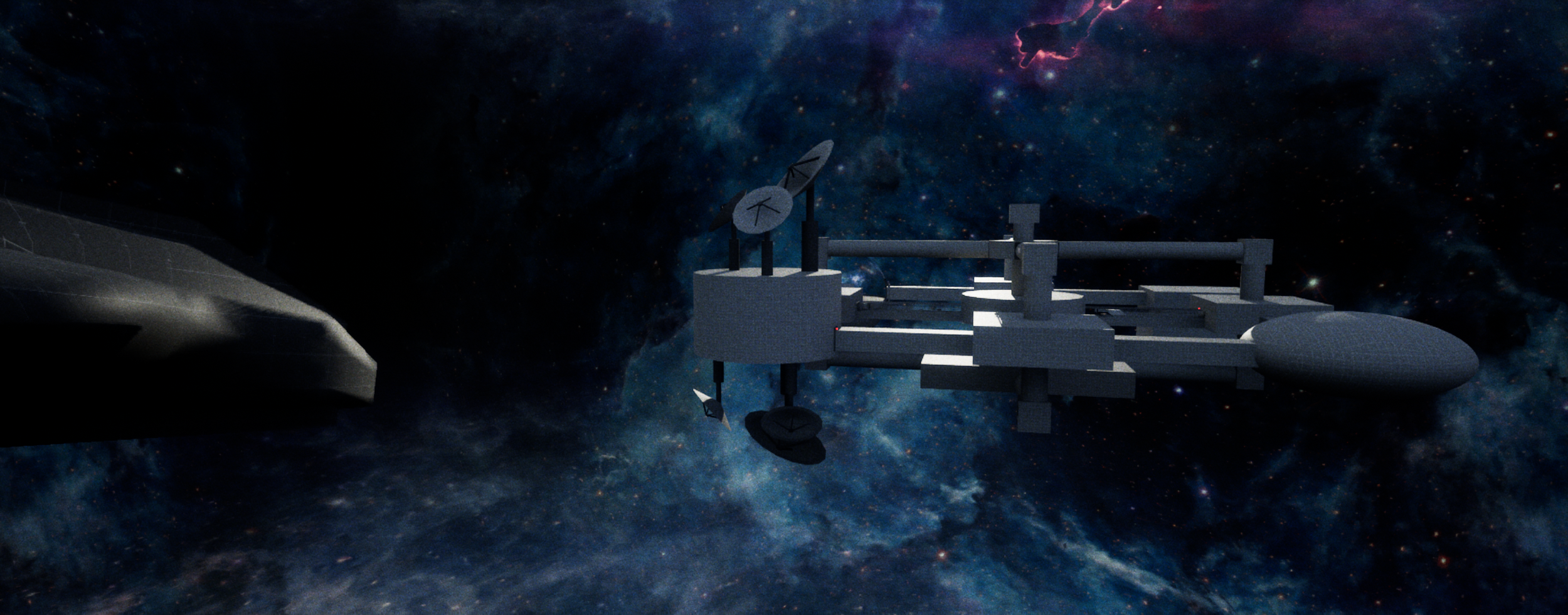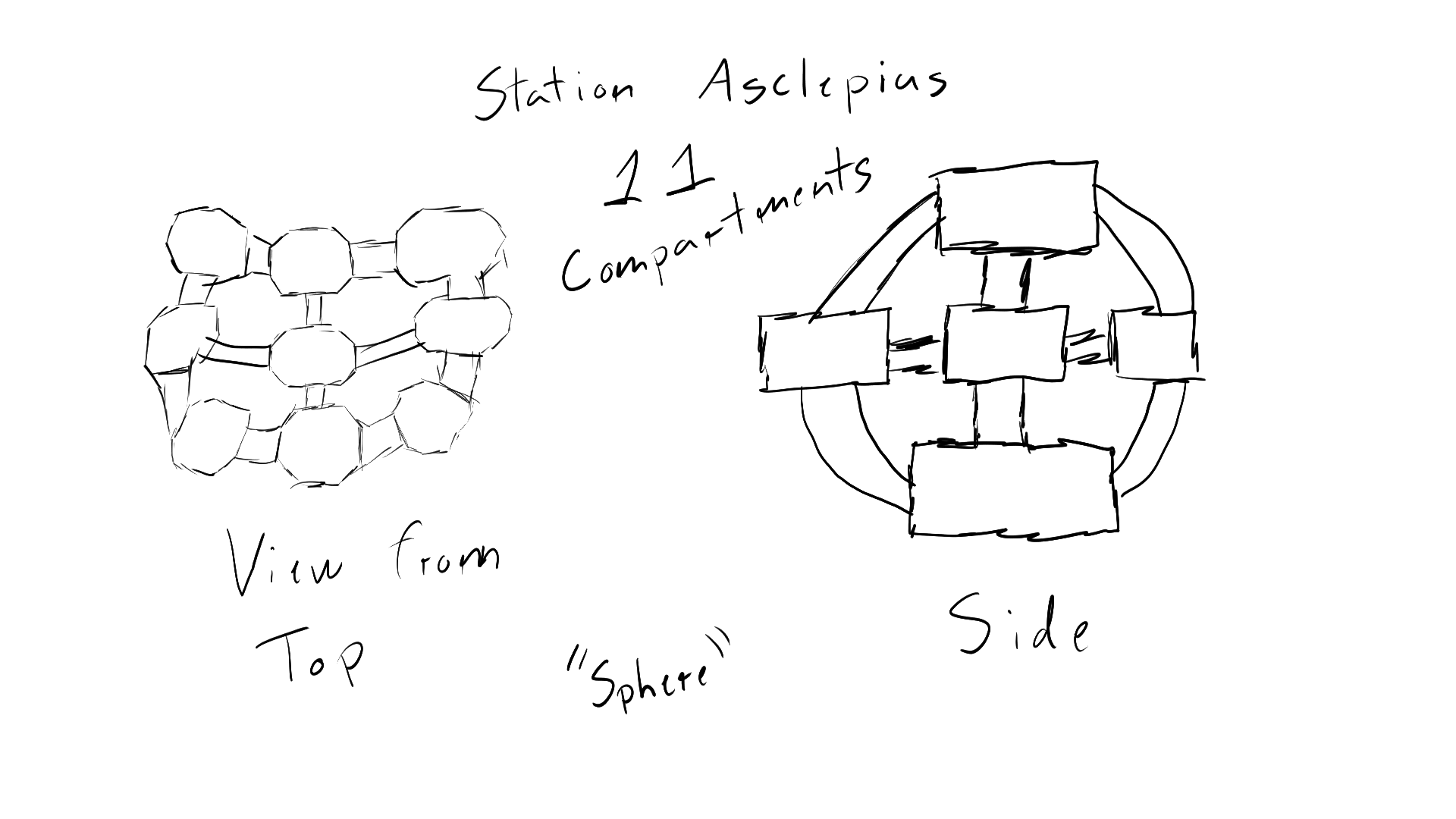Asclepius
Type: Personal Project
Development: 3 Weeks Half-Time
Description: Asclepius is a 1st-person shooter set on the Station Asclepius. The Station Asclepius serves as a luxury health resort far outside the reach of current governments. The station has sent out a service call detailing intermittent power issues and needs a mechanic off-site to take a look. The player as the mechanic starts the level inside of their own shuttle, a couple of minutes out from docking at the station.
Purpose: Looking Glass Studios and the Immersive Sim genre has always been a genre I have wanted to work in. With Asclepius, I wanted to see if I could create a small prototype from that genre. Could I nail the immersive world? Could I create flexible systems that could be used in a variety of different contexts? Am I out of my mind for even thinking of trying this? Probably, but we will learn something. That’s all I need.
Tools Used: Unreal 5, Blueprints, Photoshop, Miro, PureRef
Concepting
(Early brainstorming for Asclepius station, focusing on an interconnected space that was modular)
When I set out to make this level I wanted to use Bioshock as a tonal weathervane. This meant keeping to a large interior space and emphasizing narrative more than I had in previous levels. A space station is a different enough setting from Bioshock while keeping similar constraints/focus (also a nice nod to System Shock that came before).
Keeping scope in mind I wanted to focus on a particular moment from Bioshock to try and replicate. Fort Frolic immediately came to mind but given the time constraints wasn’t realistic. What came next to mind is the intro to Bioshock. This changed my initial motivation as Bioshock’s intro is more about setting a space/narrative/characters than playing around in an immersive SIM sandbox. This meant going forward I would need to be lighter on the immersive sim elements and emphasize narrative triggers more.
Whiteboxing
Blockout Measurements
Using Bioshock as an initial reference I created standardized sizes for doors/crawl spaces/step heights/jumps/enemies/and more. I tried to keep the station’s macro structures varied but modular. I knew I would not be able to build out the entire station in detail so had to choose my battles here.
Testing Systems/Interactions
With my larger structures built out, I wanted to develop some proxy systems/mechanics. One of the more notable proxy mechanics was the shock attack. By attaching a custom-made shock component to any actor I could easily prototype custom behavior per actor. Stun an enemy? Open a door? Shock an entire body of water and kill anything inside? Can be quickly and easily implemented.
Creating The Enemy AI
In the first Bioshock, one of the more notable enemy mob units is the Spider Splicer. An enemy that ambushes the player from above. It is an enemy unit that’s stuck with me and I wanted to try my hand at implementing and designing for it. One useful constraint given from this unit is I really couldn’t have much variance between my ceiling/floor as the enemy is still using the floor to navigate the space.
Major Gameplay Concepts
Flythrough Intro
Not so much an active player mechanic, but an important mechanic device to frame the overall world of the level. Locking the player into a cockpit view better assures the player sees what I want them to see. The player does have free movement of their head during these sequences to give the player some amount of freedom.
Zero-G Movement
Currently relegated to only the first half of the level but an effective additive mechanic to the overall setting. Currently, this mechanic exists more or less in a vacuum (get it?). If I were to continue work on this level I would like to incorporate zero-g movement into the other gameplay systems for Asclepius.
Trigger-Based Story Sequences
As the player progresses through the level they will hit in-game triggers that will alter the play space. One of the most notable sequences in the game is the player finding out the station Asclepius is a trap when the station’s gravity turns on and find their ship destroyed in dock. This required coming up with a system that could easily toggle world gravity as well as swapping character controllers seamlessly.
Audio/UI Characters
In Asclepius the player character is silent. Therefore the story/narrative of the level will have to take place through the environment as well as other, outside characters. When the player hits various triggers a portrait of a character will show up in the lower right of the screen as audio for that character plays.
Combat
In keeping with titles like Bioshock I wanted combat to incorporate more unique elements than just gun + melee enemy. The player character will have use of a shock ability that will stun enemies as well as affect various environmental objects around them. The current iteration of the enemy can not only traverse the ground but can travel via the station’s ceiling as well. This divides up the combat space as the player will need to be aware of what is above them as well as below.
Level Flow
Docking
The opening gameplay segment to Asclepius is very directed, with only the player being able to move their viewport as they approach the station. Not only does this mirror Bioshock’s introduction to rapture but also establishes our level’s world. The player is in a remote space, the station is having power issues, and you are the lucky person to fix it. Constraining the player makes sure we more effectively communicate necessary information at the start.
Entering Asclepius
Once the player is docked the level introduces them to zero-g movement and the non-traditional layout of the space station and how they connect. By docking at the “top” of the station we force the player to “dive” down using zero-g movement. Though the level re-introduces gravity later in the level, the player is now introduced to this movement mechanic and the level could make use of it later.
Explosion
Using red lights for locked doors and green lights for unlocked doors we communicate to the player areas of access without breaking game immersion. Carrying this direction forward we focus the player’s eye on the next section of the station while traversing a glass-enclosed catwalk. The player hits a trigger that plays a camera shake as well as VO. This VO points the player to look back to where they had docked their now destroyed ship.
A Friendly Guide & Combat
Taking another page from Bioshock, the level highlights a necessary weapon (the wrench) for the player to pick up in a relatively dark room. The object is also placed directly between the player and the next unlocked door. This assures the player is armed for the upcoming stealth/action segments.
We also introduce a friendly character who acts as our guide through the later portions of the level. This aids our level design as we can communicate certain mechanics more explicitly without breaking immersion. How would the player know if they kept their flashlight on a dormant enemy they would wake up? A character and some helpful VO can help cross that gap.
Closing Thoughts
Late in the level, I designed an Arboretum to be a spherical open space. This was an interesting idea in theory but beyond aesthetics doesn’t offer too much to the play experience and I think detracted from the stealth segment I had planned for that section. Changing the space to be a more traditional rectangular space will lean more into our developed systems such as the roof crawling enemy and stealth systems. I also haven’t taken advantage of my electroshock system enough. The current system allows me to attach a “shock” component to any and all objects and set that object’s different states on whether it has been shocked or not.
This means unlocking doors, shocking large volumes of water, and more are pretty easily prototyped and should take up a larger presence within the overall level.
Other Projects
Flooded Subway - 3rd Person Horror Level Design/Scripting
Project Unreal (IP)
Project Lead





